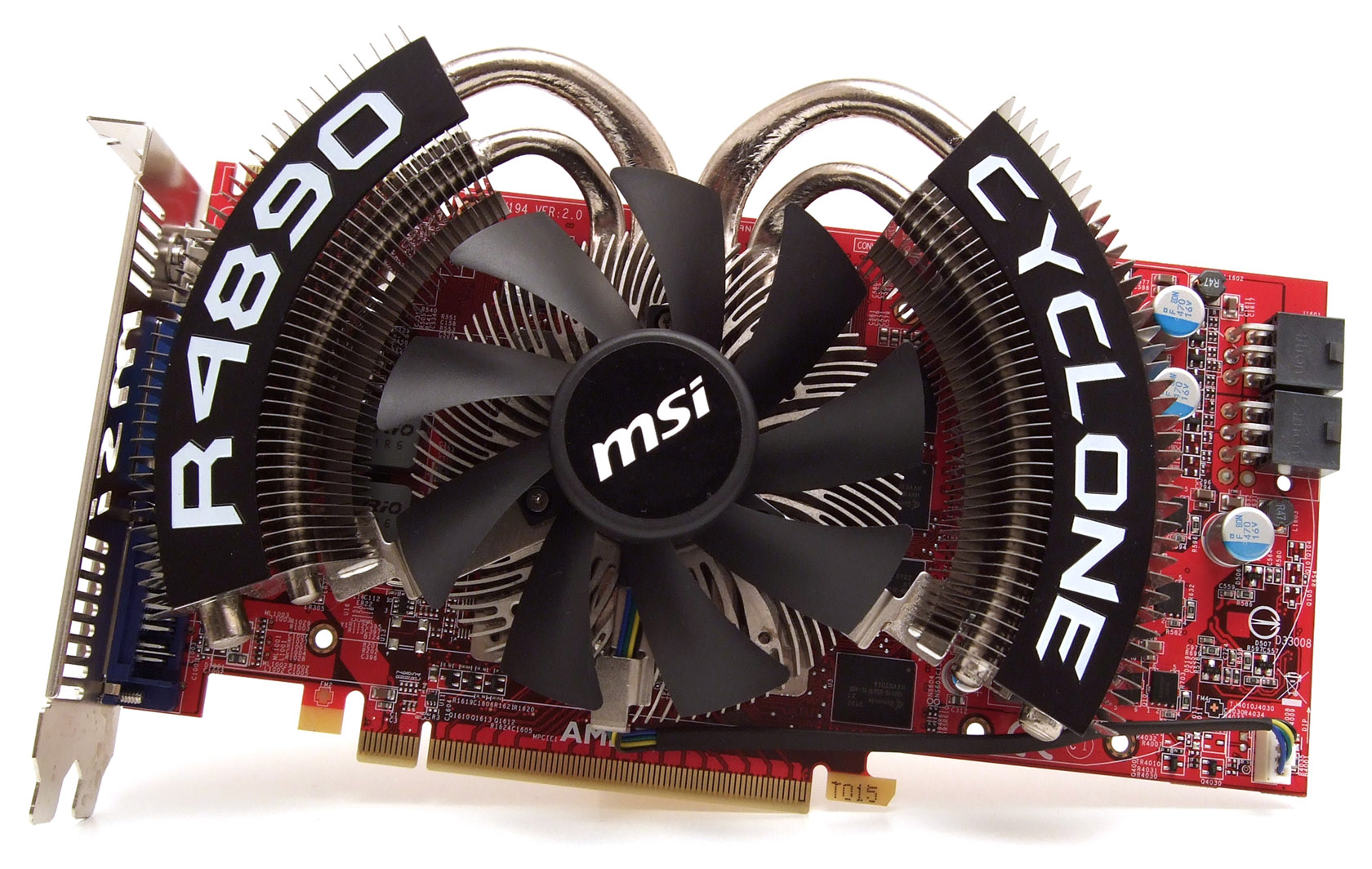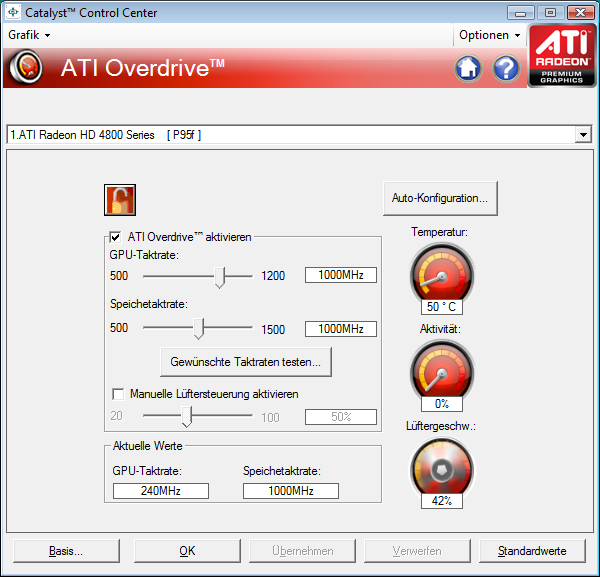Radeon HD 5770, Radeon HD 4890, And GeForce GTX 275 Overclocked
MSI R4890 Cyclone SOC: Super Overclocking
Click the image below to launch the image gallery of the MSI R4890 SOC.
Performance-wise, the Radeon HD 4890 is roughly comparable to the GeForce GTX 275. Again, MSI’s take on this card is geared completely towards overclocking, sporting 8mm heatpipes, a brawny 95mm fan, as well as "military-grade components" that can withstand higher temperatures and promise a longer life expectancy. MSI clocks both the GPU and the memory of its OC edition at 1,000 MHz rather than at 850 (GPU) and 975 MHz (memory). Thus, the graphics chip is running 17.6 percent over reference speed, while the memory speed only sees an increase of 2.6 percent. This is one of the reasons why the Radeon HD 5770’s overclocking results were so surprisingly good--its GDDR5 memory achieved more than 1,400 MHz
Again, the clock rates are hard-coded into the card’s BIOS and are set independently of any driver. The fan speed profile won’t be everyone’s cup of tea, though. When the card gets warm, the fan spins up and cools the GPU, then the fan spins down in an audible manner. Repeat infinitely. This would seem like normal behavior, but the fact that it's so noticeable can be taxing.
The MSI R4890 SOC is a veritable power hog, too, causing the system to draw no less than 196 watts in (factory-overclocked) 2D mode. Under load, our test platform maxes out at 380 watts. Increasing the speed of the GDDR5 memory has a direct impact on power consumption, since the video BIOS only scales back the GPU’s clock speed in 2D mode, but always leaves the memory running at full speed. Thankfully, the Radeon HD 5770 does not exhibit the same wasteful weakness. On the other hand, the R4890 SOC’s GPU always downclocks to 240 MHz at idle, regardless of the overclock settings selected for 3D mode.
All frequencies can be changed quite comfortably from within the Overdrive section of the graphics driver. Any changes need to be tested before the driver applies them. Still, this integrated test mode is only marginally helpful. If you overdo it with the GPU clock speed, the screen will go dark, even during the test, which can only be remedied by rebooting the system. The tool was quite reliable when it came to detecting overly-optimistic memory speeds, though. Once you’ve found clock speeds that work for you, you may still need to reduce them by 10 to 15 MHz, as some games are a little more demanding under load than ATI’s testing tool.
Once of the advantages of ATI cards in general (and the MSI HD R4890 SOC specifically) is that the graphics driver is able to reset itself without requiring the entire system to be rebooted if it encounters a GPU clock speed problem. On the downside, ATI graphics cards will freeze the system if the memory speed is set too high, while an overly aggressive GPU clock speed can also cause graphical glitches and rendering errors. Since the symptoms usually manifest the other way around, this is confusing, leading you to lower the wrong clock speed until you correctly troubleshoot the actual problem. In the end, we had to fix our clock rates manually three times after the initial driver-based test. The final result was that we were able to overclock the GPU by 21.2 percent and raised the memory frequency by 9.2 percent. Thus, the Radeon HD 4890 possesses quite a bit more overclocking potential than the GeForce GTX 275.
| Clock Speeds in MHz | GPU | Percent | Memory | Percent |
|---|---|---|---|---|
| MSI R4890 Cyclone SOC max OC | 1,030 | 121.2 | 1,065 | 109.2 |
| MSI R4890 Cyclone SOC | 1,000 | 117.6 | 1,000 | 102.6 |
| MSI R4890 Cyclone SOC no OC | 850 | 100.0 | 975 | 100.0 |
The overclock also yields better results on MSI’s overclocked ATI card. Whereas the OC edition of the GTX 275 gained 5.5 percent performance compared to a reference card using Nvidia’s specified clock speeds, the factory overclocked Radeon HD 4890 started off with a performance advantage of 10.9 percent over its reference-clocked relative, widening that gap to 14.9 percent through manual overclocking. Even at maximum speed, MSI’s GTX 275 only managed to beat the reference card by 9.6 percent.
Get Tom's Hardware's best news and in-depth reviews, straight to your inbox.
| Graphics Card and Chip Class | FPS | Percent |
|---|---|---|
| MSI R4890 Cyclone SOC max OC (HD 4890 1,024MB) | 1,750.6 | 114.9 |
| MSI R4890 Cyclone SOC (HD 4890 1,024MB) | 1,689.6 | 110.9 |
| MSI R4890 Cyclone SOC no OC (HD 4890 1,024MB) | 1,543.4 | 101.3 |
| Radeon HD 4890 (1,024MB) | 1,523.6 | 100.0 |
Current page: MSI R4890 Cyclone SOC: Super Overclocking
Prev Page MSI N275GTX Lightning: Fully Overclocked Next Page Benchmark Results: Fallout 3-
amdgamer666 Nice article. Ever since the 5770 came out I've been wondering how far someone could push the memory to relieve that bottleneck. Being able to push it to 1430 allows it to be competitive to it's older sibling and makes it enticing (with the 5700 series' extra features of course)Reply -
Onyx2291 Damn some of these cards run really well for 1920x1200 which I run at. Could pick up a lower one and run just about anything at a decent speed if I overclock well. Good ol charts :)Reply -
skora If you're trying to get to the next cards performance by OCing, shouldn't the 5850 be benched also? I know the 5770 isn't going to get there because of the memory bandwidth issue, but you missed the mark. One card is compared to its big brother, but the other two aren't.Reply
I am glad to see the 5770 produce playable frame rates at 1920x1200. Nice game selection also. -
quantumrand I'm really disappointed that they aren't any benchmarks from the 5870 or 5850 series included. Why even bother with tha GTX 295 or 4870x2 and such without the higher 5-series Radeons?Reply
I mean if I'm considering an ATI card, I'm going to want to compare the 5770 to the 5850 and 5870 just to see if that extra cost may be justified, not to mention the potential of a dual 5770 setup. -
presidenteody I don't care what this article says, when the 5870 or 5970 become available i am going to buy a few.Reply -
kartu Well, at least in Germany 4870 costs quite a bit less (30-40 Euros) compared to 5770. It would take 2+ years of playing to compensate for it with lower power consumption.Reply -
kartu "Power Consumption, Noise, And Temperature" charts are hard to comprehend. Show bars instead of numbers, maybe?Reply -
arkadi Well that put things in prospective. I was really happy with 260gtx numbers, and i can push my evga card even higher easy. To bad we didn't see the 5850 here, it looks like the optimal upgrade 4 gamers on the budget like my self. Grade article overall.Reply -
B16CXHatch I got lucky with my card. Before, I had a SuperClocked 8800GT from EVGA. I ordered a while back, a new EVGA GeForce GTX 275 (896MB). I figured the extra cash wasn't worth getting an overclocked model particularly when I could do it myself. I get it, I try to register it. The S/N on mine was a duplicate. They sent me an unused S/N to register with. I then check the speeds under one utility and it's showing GTX 275 SuperClocked speeds, not regular speeds. I check 2 more utilities and they all report the same. I had paid for a regular model and received a mislabeled SuperClocked. Flippin sweet.Reply
Now they also sell an SSC model which is overclocked even more. I used the EVGA precision tool to set those speeds and it gave me like 1 or 2 extra FPS is Crysis and F.E.A.R. 2 already played so well without overclocking. So overclocking on these bad boys doesn't really do much. Oh well.
One comment though, GTX 275's are HOT! Like, ridiculously hot. I open my window in 40 degree F weather and it'll still get warm in my room playing Team Fortress 2. -
With the 5970 out there seems to be nothing else about graphic cards that interests me anymore :D Its supposed to be the fastest card yet and beats Crysis too!Reply

